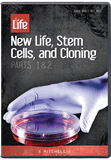
Cloning Used to Make Usable Stem Cells
A clone by any other name . . . .
News Source
- NHS–U.K.: “Cloning Method Used to Make Stem Cells”
Remember Dolly? Dolly the sheep started life as an embryonic clone produced by somatic cell nuclear transfer (SCNT). SCNT is a process in which the genome of an oocyte (egg cell) is replaced with the genome from a body cell. Researchers trying to find alternative sources of human embryonic stem cells have been trying to do the same thing, although their plan is to destroy the embryos while harvesting their stem cells, not to grow a cloned person. The New York Stem Cell Foundation Laboratory has just published news of their unique breakthrough in the October 6 edition of Nature.
Back in 2004, Woo Suk Hwang fraudulently claimed he’d succeeded in this back-door way to produce embryonic stem cells (ESCs). The furor included not only concerns about scientific fraud but also ethical concerns arising from the fact that a cloned human embryo is just as much a human embryo as an IVF-surplus embryo is. Researchers from Dieter Egli’s lab have been careful to avoid words like clone and even embryo—in fact, neither word appears in their paper. Instead, the embryos are called “activated human oocytes.”1
Since embryonic stem cells can trigger rejection in a recipient, researchers hope to produce ESCs by cloning a patient’s own body cells, thus producing an ESC line that would not be rejected.
Since embryonic stem cells can trigger rejection in a recipient, researchers hope to produce ESCs by cloning a patient’s own body cells, thus producing an ESC line that would not be rejected. Such personalized ESCs would come from embryos grown from “activated human oocytes.” A personalized “activated human oocyte” would consist of a donated oocyte with its own genome removed and the genome from the patient inserted. When allowed to develop, these “activated human oocytes” would theoretically demonstrate that they are truly embryos by multiplying until they are identifiable as blastocysts. At that time, the stem cells would be harvested from the embryos and be used to develop a treatment for the patient.
Even though these “embryos” did not originate from the union of a sperm and egg, the fact that they can develop into a blastocyst and beyond and are therefore true embryos is illustrated by the experience with Dolly. When this procedure was carried out with sheep cells, the result was an embryo that became Dolly. However, human clones have been less cooperative than Dolly, dying at the six to ten cell stage.
Egli’s group, after managing to secure an abundant source of donated human oocytes by working out an ethical way to pay donors, was able to successfully produce an embryo that survived until the blastocyst stage when its stem cells could be harvested. These embryos, however, only survived to the blastocyst stage if the original oocyte genome was left in the egg when the additional genome was added. Thus, these triploid embryos were not true clones. However, because these “activated oocytes” developed into blastocysts, and because the SCNT technology has already been proven able to produce a sheep, these triploid blastocysts were true embryos.
The researchers have shown there is something about the presence of the original genome necessary to the cloning process in humans. They hope to identify the needed factor and produce true cloned embryos. Again, of course, they would prefer to avoid calling them clones or embryos.
Since the goal of this research is ultimately to tailor-make matching stem cells for a patient, the competing technology is the induced pluripotent stem cell (iPSC) approach. Induced pluripotent stem cells can be made to match the patient’s genome. Such iPSCs should therefore be immune to rejection just like the clone-derived embryonic stem cells (ESCs) sought here. The authors point out that iPSCs can generate tumors. They neglect to mention that ESCs do the same thing.
Furthermore, Harvard stem cell expert George Daley points out the therapeutic impracticality of using these cloning techniques to personalize care for individual patients. He writes, “Realistically, however, SCNT is a cumbersome process that cannot be readily scaled to allow widespread therapeutic use.”2
Neither adult stem cells—which have produced a number of therapeutic successes—nor iPSCs, for which research is still in the early stages, form embryos or cause the ethical problems that go with them. But cloned embryos cannot stay below the ethical radar.
This scientific discovery has been accompanied by a diversionary approach to its ethical implications.
This scientific discovery has been accompanied by a diversionary approach to its ethical implications. The researchers address only the ethical concerns surrounding oocyte acquisition. As one Nature editorial asserts, this is “a technique that bypasses ethical concerns about exploiting fertilized embryos for their medical potential.”3
And since a triploid embryo is non-viable, the human-ness of the embryo can be quietly ignored for a time. Another Nature editorial, however, does shine the light on the real ethical issue, saying, “They do not use the term cloning. . . .The latest paper refers only to the reprogramming cells to a pluripotent state. A final issue—that embryos are destroyed in the process of the research—does still apply (emphasis ours).”4
We recently discussed some of the issues related to embryonic stem cells in Embryo Protection. Human life begins when a cell equipped to grow as an embryo is created. Whether that embryo is created in the laboratory or in a human fallopian tube, whether that embryo is produced by the union of a sperm and egg or by SCNT into an oocyte, whether that embryo has genetic abnormalities as do many naturally conceived babies—that embryo is still an innocent human life that we cannot ethically, morally, and biblically ignore.
Human embryos are being created and then destroyed, whether at the six to ten cell stage or as triploid blastocysts. And once Egli or others determine what “factors” are needed to make the cloning procedure as successful as Dolly’s, normal diploid embryos will be giving up their lives to provide ESCs on a regular basis.
God created human life in His image and has the authority to prohibit murder. Those embryos are human life precious to God (Psalm 51:5, 139:13–15; Jeremiah 1:5) whether they are IVF surplus or cloned creations. Harvesting their stem cells is therefore murder.
Further Reading
- The Debate over Stem Cells
- Stem Cells
- When Does Life Begin?
- Get Answers: Cloning
For More Information: Get Answers
Remember, if you see a news story that might merit some attention, let us know about it! (Note: if the story originates from the Associated Press, FOX News, MSNBC, the New York Times, or another major national media outlet, we will most likely have already heard about it.) And thanks to all of our readers who have submitted great news tips to us. If you didn’t catch all the latest News to Know, why not take a look to see what you’ve missed?
(Please note that links will take you directly to the source. Answers in Genesis is not responsible for content on the websites to which we refer. For more information, please see our Privacy Policy.)
Footnotes
- Scott Noggle et al., “Human Oocytes Reprogram Somatic Cells to a Pluripotent State,” Nature 478 (October 6, 2011): 70–75, doi:10.1038/nature10397.
- George Q. Daley and Jan Helge Solbakk, “Stem Cells: Triple Genomes Go Far,” Nature 478 (October 6, 2011): 40–41, doi:10.1038/478040a.
- Insoo Hyun and Paul Tesar, “Stem cells: Cloning Advance Calls for Careful Regulation,” Nature 478 (October 6, 2011): 36–37, doi:10.1038/478036c.
- “High-interest clones,” Nature 478 (October 6, 2011): 5, doi:10.1038/478005a.
Recommended Resources

Answers in Genesis is an apologetics ministry, dedicated to helping Christians defend their faith and proclaim the good news of Jesus Christ.
- Customer Service 800.778.3390
- © 2024 Answers in Genesis



